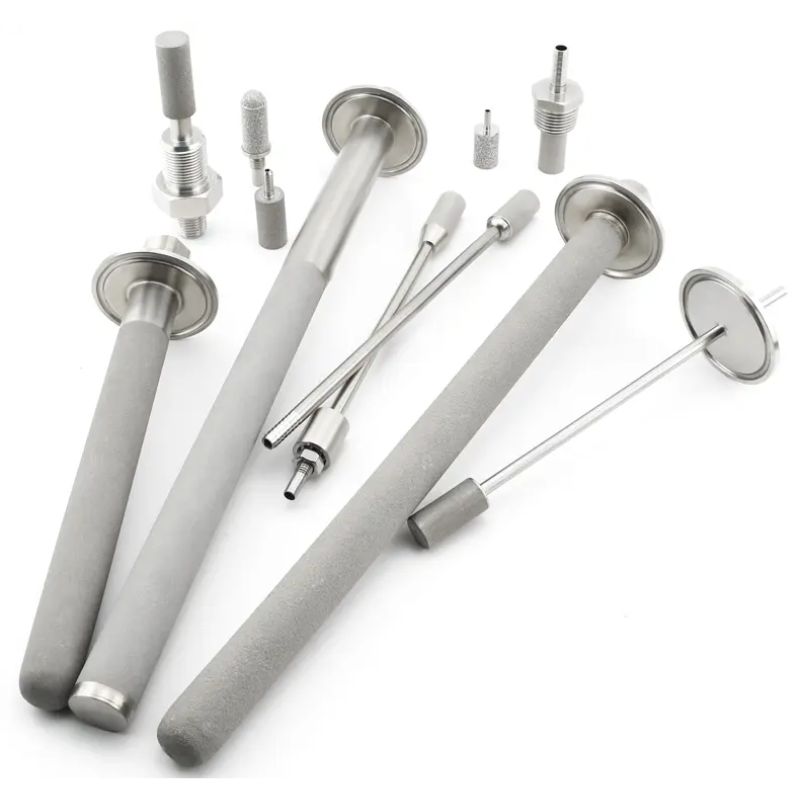Full Guide of Carbonation Stone You Should Interested Know
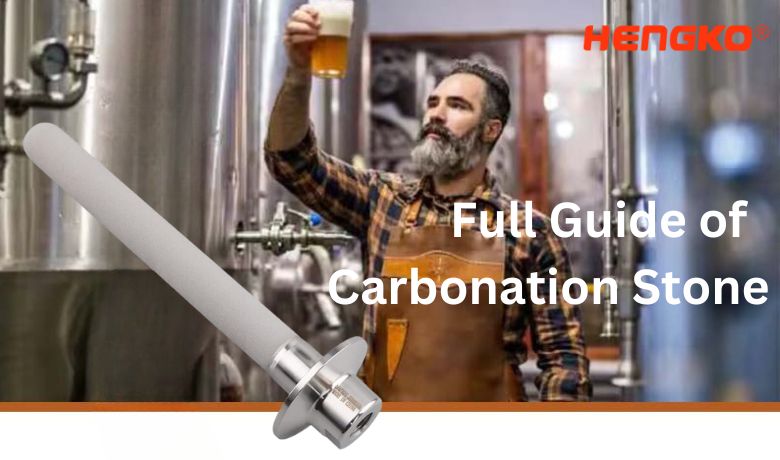
Carbonation is the process of infusing carbon dioxide (CO2) gas into a beverage. In brewing, it plays a vital role in creating the desired mouthfeel, flavor profile, and even preservation of beer. Here's how:
*Mouthfeel: CO2 creates a pleasant effervescence or "prickliness" on the tongue, which is a signature characteristic of most beers.
*Flavor Profile: Carbonation enhances the perception of bitterness from hops and accentuates other flavors in beer.
It also helps to carry volatile aromas to the nose.
*Preservation: CO2 helps to prevent the growth of spoilage organisms by creating an inhospitable environment.
What is a Carbonation Stone?
A carbonation stone, also known as a carb stone, is a tool used by homebrewers and professional brewers alike to carbonate their beer.
It's a small, cylindrical device made of sintered stainless steel with a porous structure.
The stone is placed inside a keg or fermentation tank filled with beer, and CO2 gas is forced through it.
The tiny pores in the stone diffuse the CO2 gas into the beer, creating a large surface area for the gas to dissolve.
This process efficiently carbonates the beer without stirring or agitating it, which can introduce unwanted flavors and aromas.
Manufacturing Process of Stainless Steel Carbonation Stones
Materials We Used:
* High-grade stainless steel powder (typically 316 grade for its corrosion resistance)
Process Overview:
The manufacturing of stainless steel carbonation stones involves a technique called sintering. Here's a breakdown of the steps:
1. Powder Preparation:
Highly purified stainless steel powder is used as the base material.
2. Molding:
The powder is precisely deposited into a mold that determines the final shape and size of the stone.
3. Sintering:
The filled mold is subjected to high pressure and heat. This process bonds the stainless steel particles
together without melting them, creating a rigid structure with a network of tiny pores.
4. Cooling and Cleaning:
The sintered stone is slowly cooled to prevent warping and then cleaned to remove any residual materials.
5. Passivation:
The stone is dipped in a solution like nitric acid to form a chromium oxide layer on the surface.
This enhances corrosion resistance and ensures a smooth, sanitary finish.
6. Finishing Touches:
The stone may undergo final shaping, polishing, and attachment of fittings (like a ferrule) depending on the design.
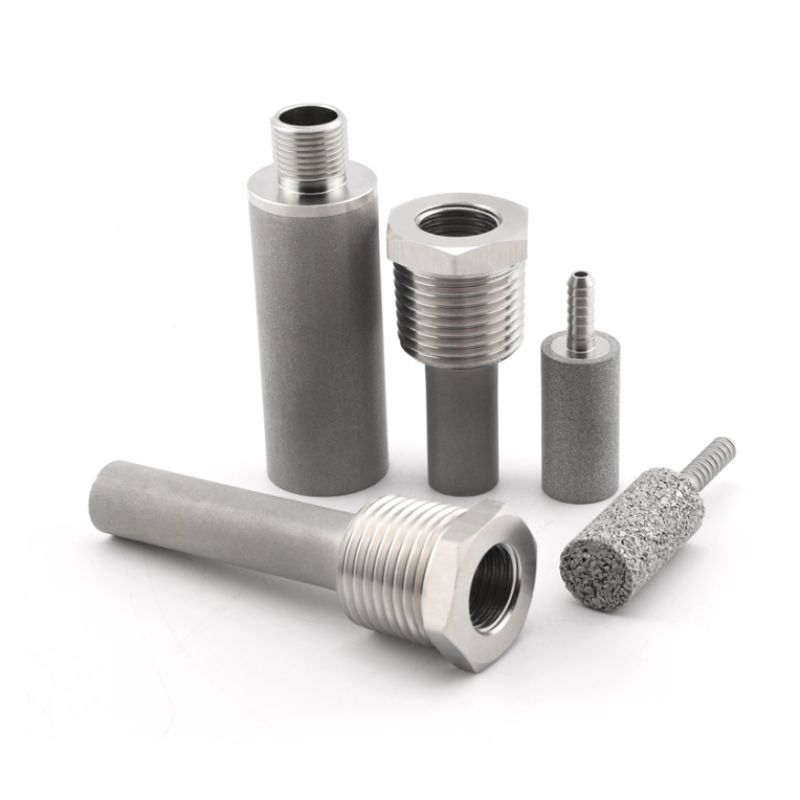
Main Features and Advantages
Carb stones offer several advantages over other carbonation methods, making them popular among home and professional brewers. Here's a breakdown of their key features:
Durability and Longevity:
*Made from high-grade stainless steel, carb stones are resistant to corrosion and can withstand high pressures and temperatures
commonly encountered during brewing.
*With proper cleaning and maintenance, they can last for many batches, making them a cost-effective investment in the long run.
Ease of Cleaning:
*Unlike some other carbonation methods, carb stones are relatively simple to clean.
*Their smooth, stainless steel surface allows for easy removal of residue, and they can be sanitized using common brewing sanitizers.
This promotes good brewing hygiene and reduces the risk of contamination.
Consistent Carbonation:
*The uniform porosity of carb stones ensures consistent diffusion of CO2 gas into the beer. This allows for precise control over the
level of carbonation, resulting in beers with the desired level of fizz.
*Unlike methods that rely on priming sugar, carb stones don't introduce fermentable sugars that can alter the flavor profile of the beer.
Versatility in Application:
*Carb stones can be used to carbonate a wide variety of beverages, not just beer. This makes them a versatile tool for homebrewers
who experiment with different styles or kombucha brewers seeking precise carbonation control.
*They can be used with various keg setups and fermentation vessels, offering flexibility in brewing processes.
In summary, carb stones offer a combination of durability, ease of use, precise carbonation control, and versatility,
making them a valuable tool for any brewer seeking to create consistently delicious and refreshing carbonated beverages.
Applications of Carbonation Stones: Beyond Beer
While carb stones are highly valued in the brewing industry for beer carbonation, their applications extend beyond just beer. Here's a look at their diverse uses:
1. Brewing Industry:
*Beer Carbonation in Kegs:
Carb stones are a standard tool for efficiently carbonating beer in kegs. They ensure consistent carbonation throughout large batches,
ideal for commercial breweries and kegged homebrews.
*Carbonating Craft Beers:
Carb stones are useful for specialty beers where precise control over carbonation is desired.
This allows brewers to achieve the perfect level of fizz for different beer styles.
2. Beverage Industry:
*Carbonating Soda Fountain Drinks: Carb stones are used in commercial soda fountain systems to infuse
CO2 into the syrup and water mixture, creating the familiar bubbly texture of sodas.
*Sparkling Water Production:
Some commercial sparkling water producers utilize carb stones to carbonate water for bottling.
This allows for precise control over the level of carbonation.
3. Home Brewing:
*Homebrew Beer Carbonation: Carb stones are a popular choice for homebrewers due to their ease of use,
affordability, and ability to achieve consistent carbonation in kegs or fermentation vessels. [Instructions for using a carbonation stone]
*Kombucha Carbonation:
Carb stones can be used by home kombucha brewers to achieve a controlled level of fizz in their fermented tea drinks.
Overall, carb stones offer a versatile and efficient method for carbonating various beverages, making them a valuable tool for both commercial producers and home enthusiasts.
Types of Carbonation Stones
Carb stones come in various configurations to suit different applications and keg setups.
Here's a breakdown of the most common types:
1. Tri Clamp Carbonation Stones:

*Designed for use with jacketed tanks (tanks with a double wall for temperature control)
*Feature a tri-clamp sanitary fitting for easy attachment and removal from the tank wall
*The porous stone element is typically made of sintered stainless steel
*Available in various sizes to suit the volume of the tank
2. Inline Carbonation Stones:
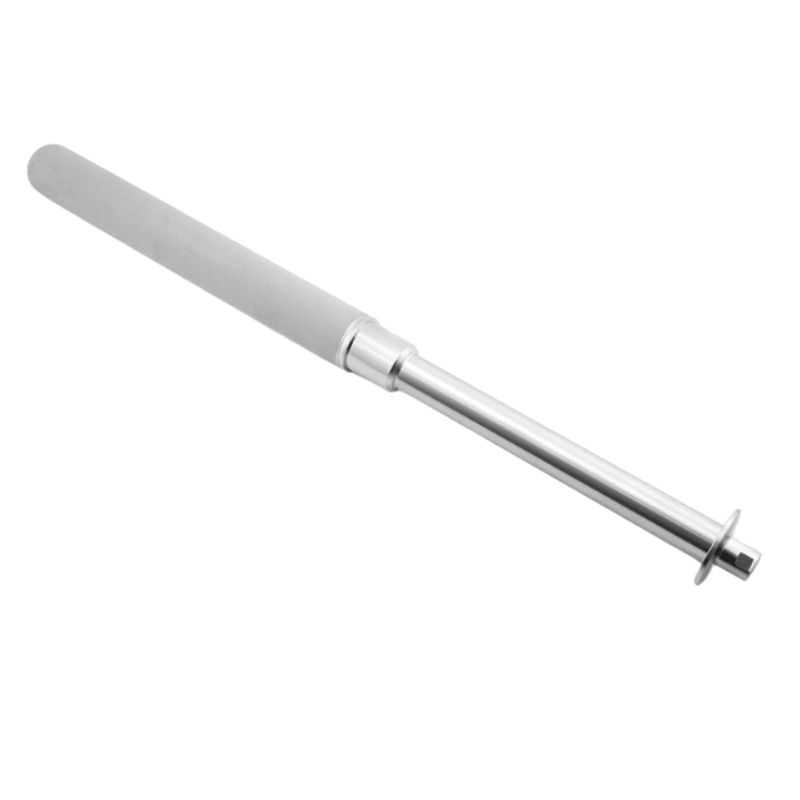
*Meant to be installed directly in the CO2 gas line within a brewing system
*The CO2 gas flows through the stone, diffusing into the liquid as it passes
*Offers efficient carbonation for large volumes of liquid
*Requires specific plumbing modifications to integrate into the system
3. Corny Keg Carbonation Stones:
*Designed specifically for use in Corny kegs, a popular type of homebrew keg
*Typically smaller than other carb stones due to the limited space inside a Corny keg
*May attach directly to the dip tube or gas post within the keg
*Easy to use and ideal for homebrewers
Choosing the right type of carb stone depends on your specific brewing setup and keg type.
Tri clamp stones are best for jacketed tanks, inline stones for large-scale operations, and Corny keg stones for homebrewing with Corny kegs.
3-Steps Choosing the Right Carbonation Stone for Your System:
Selecting the ideal carb stone requires considering a few key factors to ensure compatibility and optimal performance in your brewing setup. Here's a breakdown of the crucial aspects to consider:
1. Compatibility with Equipment:
This is the most important factor.
Your chosen carb stone must have the appropriate fitting to connect to your keg or tank.
Here are common types:
*Tri Clamp Carb Stones: These connect to jacketed tanks via tri-clamp fittings.
*Inline Carb Stones: Installed directly into the CO2 gas line of your brewing system.
*Corny Keg Carb Stones: Designed specifically to fit inside Corny kegs, often attaching to the dip tube or gas post.
2. Size of the Stone:
*The size of the carb stone should be appropriate for the volume of your vessel.
*Larger stones ensure efficient carbonation for bigger tanks, while smaller stones are
suitable for Corny kegs or homebrew setups.
3. Pore Size of the Stone:
Pore size influences the diffusion rate of CO2 gas into your beverage.
*Smaller pores (0.5 to 1 micron): Create finer bubbles and slower carbonation but less risk of clogging.
*Larger pores (2 to 3 microns): Enable faster carbonation but may lead to coarser bubbles and potential clogging from proteins or hop particles.
Here are some additional tips for choosing a carb stone:
*Material: Opt for a 316L grade stainless steel carb stone for optimal durability and corrosion resistance.
*Brand Reputation: Consider reputable brands known for quality and consistency in their carb stones.
*User Reviews: Reading reviews from other brewers can provide valuable insights into the performance and ease of use of different carb stones.
By carefully considering these factors, you can select the right carb stone that ensures efficient and consistent carbonation for your brewing needs.

Installation and Usage Tips for Your Carbonation Stone
Carb stones are relatively simple to use, but proper installation and maintenance techniques are crucial for optimal performance and to avoid contamination. Here's a guide to get you started:
Proper Installation:
1.Match the Stone to Your System:
Ensure your chosen carb stone has the correct fitting for your keg or tank (tri-clamp, inline, or Corny keg specific).
2.Sanitize Everything:
Before installation, sanitize the carb stone, keg/tank, and any connecting components using a no-rinse sanitizer suitable for brewing.
3.Install the Stone:
Follow the specific instructions for your chosen carb stone type. Here are general guidelines:
4.Tri-Clamp:
Attach the stone to the designated tri-clamp port on your jacketed tank.
5.Inline:
Integrate the stone into your CO2 gas line according to the manufacturer's instructions.This may involve plumbing modifications.
*6.Corny Keg:
Depending on the design, the stone might connect to the dip tube or gas post inside the keg.
7.Attach the CO2 Line:
Connect your CO2 gas line to the appropriate fitting on the keg or tank, ensuring a secure connection.
Maintenance and Cleaning:
*After each use, disassemble the carb stone (if possible) and soak it in a warm sanitizing solution.
*You can also use a no-rinse sanitizer or a citric acid solution for cleaning.
*Avoid using harsh chemicals or abrasive cleaners that can damage the stone's porous structure.
*Regularly inspect the stone for any blockages or damage. If necessary, replace it with a new one.
Troubleshooting Common Issues:
*Slow Carbonation:
This could be due to a clogged stone, low CO2 pressure, or cold beer temperature.
Check for blockages, ensure your pressure is set correctly for your desired carbonation level,
and consider slightly warming the beer (ideally to 30-32°F).
*Excessive Foaming:
This might indicate using a stone with large pores or excessively high CO2 pressure.
Try a stone with smaller pores or reduce the pressure slightly.
FAQ
Carb stones are a popular choice for industry brew and home brewers looking to carbonate their beer in Corny kegs.
Here are some frequently asked questions and detailed answers to guide you:
1. Are carb stones effective for carbonating beer in a Corny keg?
Absolutely! Carb stones are a very effective method for carbonating beer in Corny kegs. They offer several advantages:
*Efficient Carbonation:
The porous structure of the stone allows for a large surface area for CO2 to diffuse into the beer,
leading to faster and more consistent carbonation compared to shaking or spunding.
*Precise Control:
You can control the carbonation level by adjusting the CO2 pressure. Unlike priming sugar, carb stones
don't introduce fermentable sugars that can alter the flavor profile.
*Easy to Use:
Carb stones are relatively simple to install and use, making them ideal for homebrewers of all experience levels.
2. What size carb stone do I need for my Corny keg?
Corny keg carb stones are typically smaller than those used in larger tanks due to the limited space inside the keg.
A standard 0.5 micron to 2 micron sintered stainless steel stone with a diameter of around 1 inch (2.5 cm) is
suitable for most homebrew Corny kegs.
3. How do I install a carb stone in my Corny keg?
There are two main types of Corny keg carb stones:
1. Dip Tube Attachment:
This type screws directly onto the dip tube within the keg.
*Sanitize the stone and dip tube thoroughly.
*Unscrew the dip tube cap and attach the carb stone.
*Reattach the dip tube assembly to the keg body.
2. Gas Post Attachment:
This type connects to the gas post on the keg lid. Some lids may have a dedicated port for a carb stone,
while others require a special attachment.
*Sanitize the stone and gas post.
*Follow the specific instructions for your chosen carb stone and lid type.
This might involve attaching a hose barb or adapter.
*Securely connect the carb stone to the gas post.
4. How do I carbonate my beer in a Corny keg using a carb stone?
Here's a general guide:
1. Prepare your keg:
Ensure your keg is clean and sanitized. Purge the keg with CO2 to remove any oxygen.
2. Fill your keg with chilled beer:
Ideally, the beer should be at serving temperature (around 30-32°F). Colder beer absorbs CO2 more efficiently.
3. Attach the carb stone:
Follow the installation steps mentioned earlier for your chosen type.
4. Set your CO2 regulator:
Start with a low pressure (around 5-10 psi) and gradually increase it over several hours or days until you reach your
desired carbonation level (refer to a carbonation chart for specific pressures based on beer style and temperature).
5. Monitor the pressure:
Check the pressure gauge on your regulator periodically to ensure it stays consistent.
6. Allow time for carbonation:
Depending on the temperature, pressure, and desired level of carbonation,
it can take 24-72 hours for your beer to be fully carbonated.
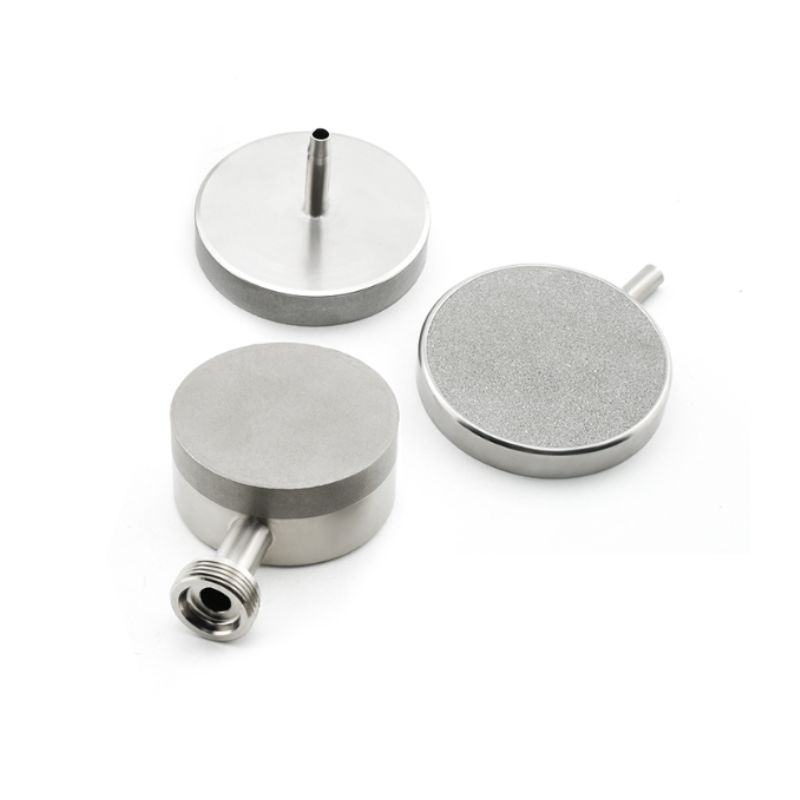
5. Can I leave the carb stone in the keg while serving?
It's generally not recommended to leave the carb stone in the keg while serving for a few reasons:
*Sediment Disturbance:
The continuous flow of CO2 through the stone can stir up sediment at the bottom of the keg, leading to a cloudy beer.
*Excessive Foaming:
The constant introduction of CO2 can cause excessive foaming during pouring.
Here are two options to consider:
*Remove the stone after carbonation:
Once your beer is carbonated, detach the carb stone and replace it with a regular dip tube or
gas post cap before serving.
*Use a dedicated keg with a carb stone:
If you frequently use carb stones, consider dedicating a keg specifically for this purpose.
Leave the stone in the keg and simply swap out the keg when serving.
6. How do I clean my carb stone?
After each use, disassemble the carb stone (if possible) and soak it in a warm sanitizing solution suitable for brewing.
You can also use a no-rinse sanitizer or a citric acid solution.
Avoid harsh chemicals or abrasive cleaners that can damage the stone's pores.
Rinse thoroughly with clean water before storing it.
By following these tips and addressing these common questions, you can successfully use carb stones to
achieve consistent and delicious carbonated beer in your Corny kegs.
Conclusion
Carbonation stones are an invaluable tool for achieving perfect carbonation in your brews.
By understanding their features, advantages, and how to choose the right one, you can enhance the quality
of your beer and enjoy a more efficient brewing process.
Experiment with different types and find the perfect stone for your setup.
So Are you looking to enhance the carbonation process in your beverage industry with high-quality carbonation stones?
Contact HENGKO today to learn more about our OEM Carbonation Stone solutions.
Our experts are ready to help you find the perfect fit for your specific needs.
Reach out to us at ka@hengko.com and take your beverage production to the next level!
Send your message to us:
